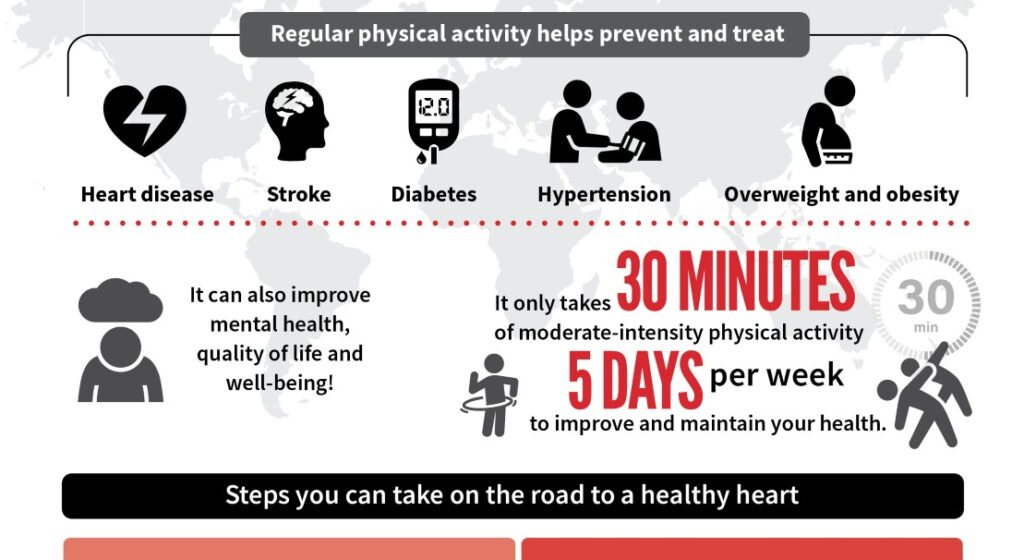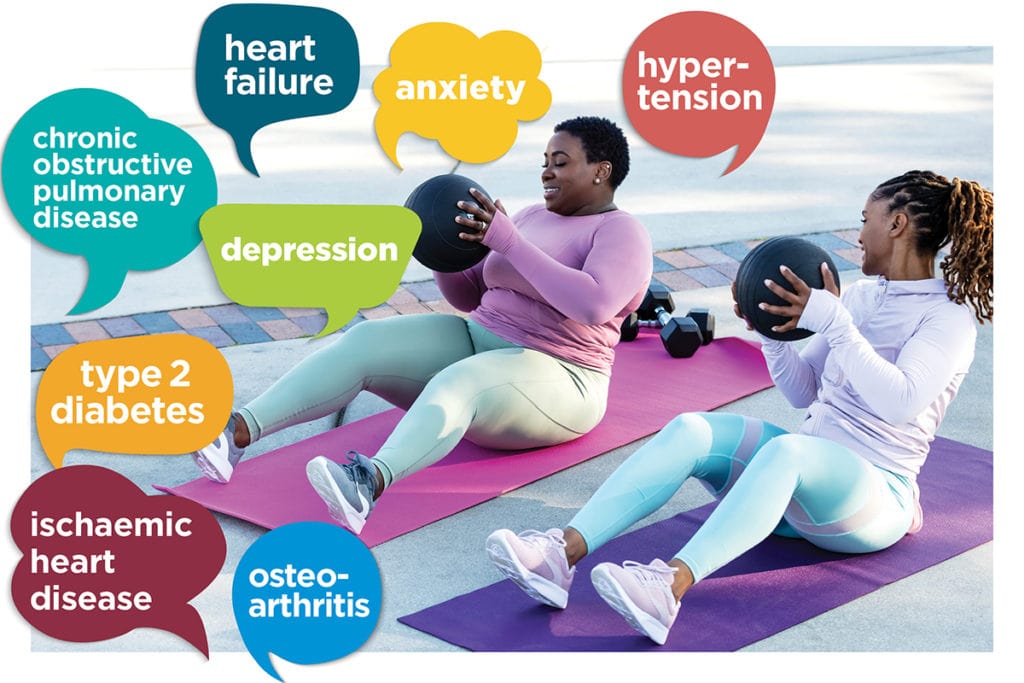Regular physical activity reduces the risk of chronic diseases like heart disease, diabetes, and cancer, while also improving mental well-being, bone strength, and immune function.
In this comprehensive guide, we’ll explore the numerous ways in which regular exercise can reduce the risk of chronic diseases, while also providing actionable tips to help you get started.
What is Regular Physical Activity?

Before delving into the connection between exercise and disease prevention, it’s important to clarify what we mean by “regular physical activity.” Physical activity encompasses any movement that requires energy expenditure, whether it’s structured exercise or simply daily activities like walking, cleaning, or gardening.
- Moderate-intensity activities: This includes brisk walking, dancing, house chores, or cycling at a casual pace. You should still be able to talk while engaging in these activities.
- Vigorous-intensity activities: These are more intense exercises like jogging, running, swimming laps, aerobic dancing, or cycling faster than 10 miles per hour.
According to global health guidelines, adults should aim for at least 150 minutes of moderate-intensity aerobic exercise or 75 minutes of vigorous activity each week. This should be combined with muscle-strengthening activities on at least two days per week for optimal health benefits. If time is an issue, breaking exercise into short 10-15 minute sessions can still provide significant health benefits.
How Physical Activity Protects Against Chronic Diseases:
Chronic diseases, such as cardiovascular disease, type 2 diabetes, and certain types of cancer, develop over time, often due to poor lifestyle choices like lack of exercise, unhealthy diets, and smoking.
Regular physical activity acts as a powerful preventive tool because it helps maintain a healthy weight, improves body function, and boosts the immune system. Let’s break down how exercise reduces the risk of specific chronic diseases.
Physical Activity and Cardiovascular Health:
Cardiovascular diseases (CVD), which include heart attacks, strokes, and high blood pressure, are the leading cause of death globally. The heart is a muscle, and just like other muscles, it becomes stronger with regular exercise. By incorporating cardiovascular activities into your routine, you can significantly reduce your risk of heart disease.
- Improved blood circulation: Regular exercise enhances blood flow throughout the body, ensuring that oxygen and nutrients reach all organs efficiently. This reduces the risk of arterial blockages.
- Lowering blood pressure: High blood pressure (hypertension) is a key risk factor for heart disease. Aerobic exercises like running, swimming, and even walking help dilate blood vessels, reducing blood pressure levels.
- Cholesterol management: Exercise helps balance cholesterol levels by increasing HDL (good cholesterol) and lowering LDL (bad cholesterol). When LDL cholesterol accumulates, it forms plaque in the arteries, leading to atherosclerosis, which can cause heart attacks and strokes.
- Heart muscle strength: Activities like cycling and jogging train the heart to pump more efficiently, lowering the resting heart rate and reducing the overall workload on the heart.
Incorporating as little as 30 minutes of aerobic exercise into your daily routine can lower your risk of developing heart disease by up to 35%.
Also Read: Welch Allyn Pocket Scope Which Tip Is Fit – Choosing Pocket Scope Tips!
The Impact of Physical Activity on Type 2 Diabetes:
Type 2 diabetes, which affects millions of people worldwide, is closely linked to inactivity and obesity. However, regular exercise can be a game-changer for both preventing and managing this condition.
- Improved insulin sensitivity: Physical activity helps the body use insulin more effectively, which lowers blood sugar levels. This is especially important for individuals at risk of developing insulin resistance, a precursor to type 2 diabetes.
- Glucose regulation: During exercise, muscles use glucose (sugar) for energy, which reduces blood sugar levels and makes the cells more sensitive to insulin.
- Weight management: Since obesity is a major risk factor for type 2 diabetes, maintaining a healthy weight through exercise can significantly lower the risk. Regular aerobic activity can reduce visceral fat (fat around the organs), which is highly associated with insulin resistance.
Studies show that individuals who are physically active have a 50% lower risk of developing type 2 diabetes compared to those who lead sedentary lives.
Exercise and Obesity Prevention:

Obesity is one of the most significant risk factors for a variety of chronic diseases, including heart disease, diabetes, and certain cancers. Maintaining a healthy weight is critical for reducing the risk of these diseases, and regular physical activity is a key component in managing body weight.
- Caloric expenditure: Weight gain occurs when you consume more calories than your body uses. Physical activity helps burn excess calories, preventing them from being stored as fat. Engaging in regular aerobic exercise can lead to sustainable weight loss over time.
- Increased metabolism: Strength training and resistance exercises help build muscle mass, which, in turn, increases metabolism. Muscles burn more calories at rest compared to fat, making it easier to maintain a healthy weight.
- Fat distribution: Exercise plays a role in how fat is distributed throughout the body. Aerobic exercises are particularly effective at reducing abdominal fat, a dangerous type of fat that surrounds internal organs and increases the risk of chronic diseases.
Cancer Prevention and Physical Activity:
Emerging evidence suggests that regular physical activity can lower the risk of several types of cancer, including colon, breast, and endometrial cancer. While the exact mechanisms are still under research, several hypotheses explain this connection:
- Hormonal balance: Physical activity helps regulate hormone levels, particularly estrogen and insulin, which can reduce the risk of hormone-related cancers such as breast and endometrial cancer.
- Improved immune function: Regular exercise enhances immune function by promoting circulation of immune cells that can detect and fight off abnormal or cancerous cells.
- Weight control: Since obesity is a risk factor for several types of cancer, maintaining a healthy weight through physical activity can help reduce cancer risk.
For example, women who engage in physical activity for at least 30 minutes per day have a 20-30% lower risk of developing breast cancer compared to those who are less active.
Mental Health Benefits of Physical Activity:
Physical health and mental health are deeply intertwined. Engaging in regular exercise not only protects your body from physical ailments but also promotes mental well-being. Physical activity has been shown to reduce the risk of mental health disorders, including depression and anxiety.
- Endorphin release: Exercise stimulates the production of endorphins, the body’s natural mood elevators, leading to reduced symptoms of depression and a more positive outlook on life.
- Stress reduction: Physical activity can act as a stress reliever by lowering cortisol (the body’s stress hormone) and improving the ability to manage stress.
- Cognitive function: Regular exercise improves cognitive function and reduces the risk of age-related neurodegenerative conditions, such as Alzheimer’s disease. Physical activity increases blood flow to the brain, promoting better memory, focus, and problem-solving skills.
Also Read: Hks Super Air Filter Type 16 Honda Fit 2015-2020 – Performance Boost Honda Fit!
Building Strong Bones and Joints:
As we age, bone density decreases, which can lead to osteoporosis and fractures. Regular weight-bearing exercises can help combat bone loss and reduce the risk of osteoporosis. Additionally, physical activity helps maintain joint flexibility and reduces the symptoms of arthritis.
- Bone strength: Activities like walking, running, and resistance training stimulate bone tissue, increasing bone density and strength. This is crucial for preventing fractures, especially in older adults.
- Joint health: Regular movement helps lubricate joints and maintain a full range of motion, reducing stiffness and pain in conditions like osteoarthritis.
Tips for Incorporating Physical Activity Into Daily Life:
For many people, the hardest part of staying active is fitting it into a busy schedule. However, incorporating more physical activity into your daily routine doesn’t have to be overwhelming. Here are some practical tips:
- Set realistic goals: Start with small, achievable goals, such as walking for 10 minutes after lunch, and gradually increase the time or intensity.
- Use technology: Fitness apps and wearable devices can help track your progress and keep you motivated by showing your daily steps or calories burned.
- Incorporate exercise into your daily tasks: Take the stairs instead of the elevator, park farther from your destination, or walk or cycle instead of driving.
- Join a group: Exercising with a friend or joining a fitness class can provide social support and make physical activity more enjoyable.
- Make it fun: Find activities you enjoy, whether it’s dancing, hiking, swimming, or playing sports, so that you’ll be more likely to stick with it long-term.
FAQ’s
1. How much physical activity is recommended to reduce the risk of chronic diseases?
Adults should aim for 150 minutes of moderate-intensity or 75 minutes of vigorous-intensity aerobic activity per week, along with muscle-strengthening exercises twice a week.
2. Can exercise help prevent type 2 diabetes?
Yes, regular physical activity improves insulin sensitivity and helps regulate blood sugar levels, reducing the risk of developing type 2 diabetes by up to 50%.
3. How does physical activity reduce the risk of heart disease?
Exercise strengthens the heart, improves circulation, lowers blood pressure, and manages cholesterol levels, reducing the risk of heart disease by up to 35%.
4. Is weight loss necessary to lower the risk of chronic diseases?
While weight loss can help, regular physical activity alone can reduce the risk of chronic diseases by improving metabolism, controlling fat distribution, and enhancing overall body function.
5. Can exercise lower the risk of cancer?
Yes, physical activity can lower the risk of cancers such as colon, breast, and endometrial cancer by balancing hormones, boosting immune function, and helping maintain a healthy weight.
Conclusion
In conclusion, regular physical activity plays a crucial role in reducing the risk of chronic diseases such as heart disease, type 2 diabetes, and certain cancers. It improves cardiovascular health, aids in weight management, and enhances insulin sensitivity, while also contributing to mental well-being and bone strength. Incorporating consistent exercise into daily life is an effective preventive measure that benefits both physical and mental health.